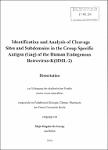Identification and Analysis of Cleavage Sites and Subdomains in the Group Specific Antigen (Gag) of the Human Endogenous Retrovirus-K(HML-2)
George, Maja
Interestingly at molecular level humans and chimpanzees are very similar. The average DNA
sequence difference between them is ~4% (Varki and Altheide, 2009). Contributing to the
difference in humans are human endogenous retroviruses (HERV), which constitute about 8%
of our genome. The young age and the similarity to other cancer causing betaretroviruses such
as MMTV have led to intense research on the influence of some HERVs on the human
genome as well as oncogenic aspects of HERV encoded proteins. Fundamental properties of
these ancient retroviruses although have remained undiscovered, due to the low expression of
the retroviral proteins. One example is the Gag polyprotein, the major structural protein of all
retroviruses with the ability to form virus like particles in the absence of any other retroviral
protein. The aim of this project was to decipher the processing sites of the Group specific
antigen (Gag) protein of a specific member of the HERV family, HERV-K113, and to identify
all cleavage products.
Although the provirus of HERV-K113 encodes open reading frames for genes of a complex
retrovirus and produces mature virions on low expression levels, it has accumulated mutations
which render it uninfectious. To elevate the expression non-synonymous post-integration
mutations in the gag-pro-pol region of HERV-K113 had previously been identified by a
specific algorithm and reconstituted. The amino acid sequence had then been codon optimized
for mammalian cell. Gag was cloned together with the protease and polymerase sequence into
the vector pcDNA3.1 to set it under the control of a CMV-promoter. Expression of this new
construct, oricoHERV-K113_GagProPol, in mammalian cells led to an enhanced viral protein
expression as seen on Western Blot and in Electron microscopic pictures of purified viral
pellets. The protease defective construct oricoHERV-K113_GagPro-Pol was established to
investigate the maturation process. Comparison of protease defective viral proteins to protease
active viral proteins on silver nitrate stained SDS gel analysis revealed the processing of Gag
proteins and the maturation of VLPs after the release from cells. Alignments of HERV-K113
Gag with the sequences of two beta retroviruses, MPMV and MMTV, had already shown that
the endogenous retroviral Gag harbours the typical domains matrix (MA), capsid (CA) and
nucleocapsid (NC) as well as a phosphorylated protein with a late domain between MA and
CA. The high expression rate of oricoHERV-K113 enabled the investigation of the exact Gag
cleavage sites. Therefore viral proteins were separated by reverse phase high pressure liquid
chromatography. Fractions were screened for Gag subdomains on western blot with previously established antibodies and, in some cases, by mass spectrometry. Proteins
suspected to contain a subdomain were N-terminally sequenced, to determine the N-terminal
cleavage site amino acid sequence. Additional to the common retroviral Gag subdomains MA,
CA and NC the subdomain p15 was confirmed between MA and CA. Typical for a late
domain encoding protein p15 was shown to be phosphorylated by mass spectrometry. All
cleavage sites except the one between MA and p15 belong to type 1 or type 2 cleavage sites.
Mutation of the P1 position at the cleavage sites led to changes in cleavage patterns detected
on Western Blot. Surprisingly two new short proteins were discovered following NC. Both are
rich in glutamine and proline and hence were named QP1 and QP2.
In summary the reconstituted protein sequence of oricoHERV-K113_GagProPol facilitated
the discovery that the HERV-K113 Gag is cleaved by the protease to release the subdomains
MA, p15, CA, NC, QP1 and QP2. The functions of QP1 and QP2 have to be investigated in
the future. Since processing is a prerequisite for replication, analysis of the subdomains and
their processing could lead to the discovery why no original or improved HERV sequence
until now has been shown to replicate.
Dateien zu dieser Publikation
Keine Lizenzangabe

